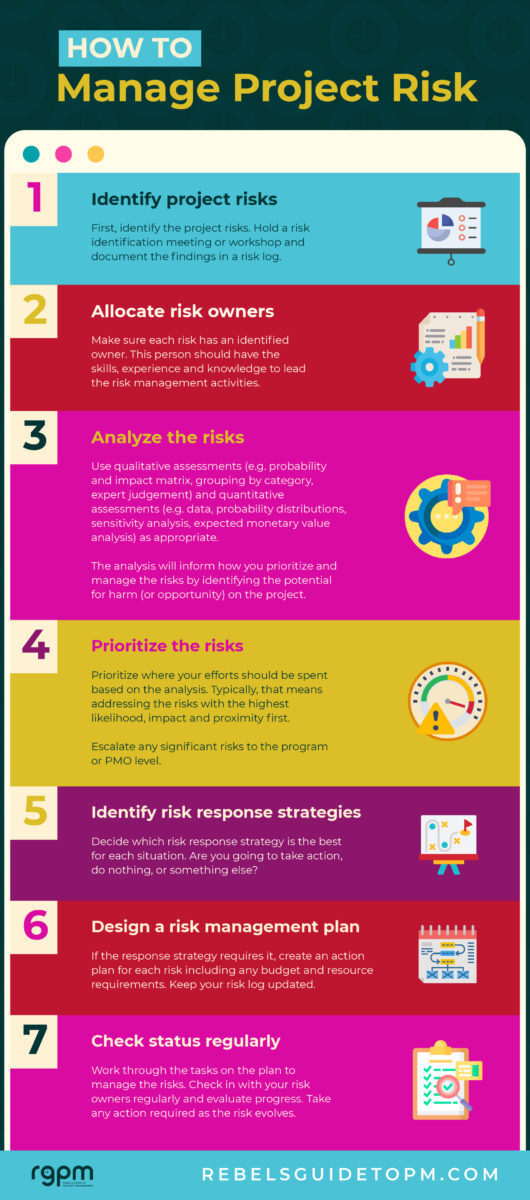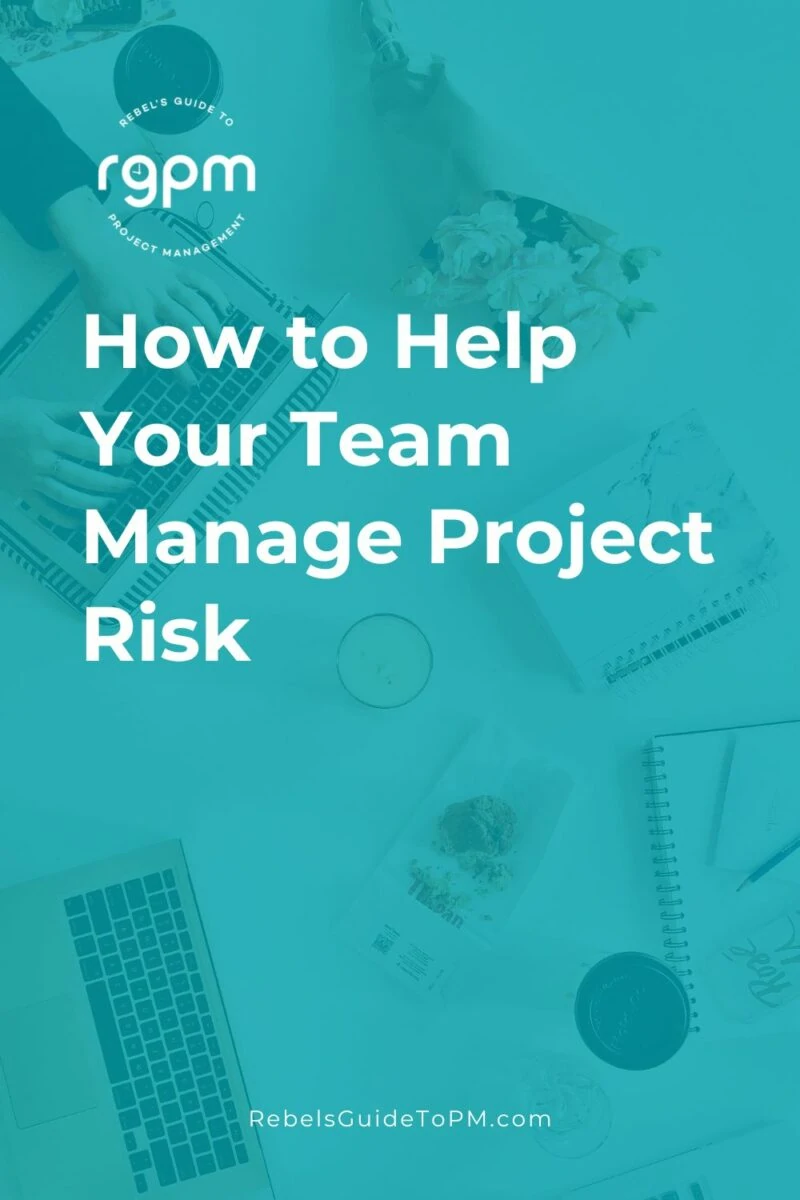How to help your team manage project risk
This blog is reader-supported. When you purchase something through an affiliate link on this site, I may earn some coffee money. Thanks! Learn more.
A project manager’s job isn’t just about managing the work. You are also responsible for your team, and making sure they have the skills required to do their jobs.
Part of a resource management plan is to build the skills of your team. Normally we’d think of that in terms of the technical skills they need to deliver the project, like taking a course in a programming language or brushing up their system maintenance skills.
However, you should also consider how good they are at doing the work of projects – project management. Yes, overall project management is your job, but why not make your life a little easier by helping your team members understand how they can be better at getting the project done?
Risk management is a great example. It’s a structured process that happens on every project and outside the project environment too, so it’s a fantastic skill to learn to boost your career and broaden your skills – whatever your job title.
Here’s how project managers can help their teams manage risk effectively, so that everyone benefits from effective risk management.
1. Identify project risks
First, identify the project risks. This is the normal first step of project risk management, and you’ll carry out your risk identification activities (probably a workshop) as you would usually do.
During the meeting it’s a good idea to give other people the chance to lead certain sections. A technical workstream manager could take the lead on the technical risk discussion, coming up to the front of the room and capturing responses on a flip chart for example.
This will give them some facilitation experience and help the team think about how to elicit risk from a group. It also gives everyone a break from only hearing your voice.
They can also get involved with other ways of identifying project risk such as:
- Documentation reviews
- Interviewing
- Preparing cause and effect diagrams
- Using risk identification checklists.
Log the project risks on a risk log. You’ll come back to that later to update it with the selected actions that you need to take to handle the risk.
2. Allocate risk owners
As the project manager, it’s sensible if you allocate the owners for each identified risk, based on their skills, experience and knowledge of the potential problem. Someone without much experience might choose owners who aren’t a good fit, so for the moment keep this task for yourself.
You can continue to coach your team through the risk management process by explaining why you have chosen those individuals as the risk owner.
You can also consider allocating two owners: a main owner and a buddy. Either of these positions could be the most experienced of the two. For example, on a low impact risk you can make the main owner the person with the least experience – the person you are trying to upskill. They can be mentored by an experienced risk owner.
On a high impact risk it would be a better choice to have the experienced risk owner in overall charge of this risk and the inexperienced team member work shadowing.
Remember that your risk owner allocation might need to change later because you haven’t done a full risk analysis at this point. Once you know the full scale of the risk it might be prudent to shift the risk ownership around in the team (or provide extra support) so you do not expose the project to problems unnecessarily.
Getting other people involved at this deep level also helps avoid Group Think.
3. Analyze the risks
The analysis process can be anything from making a qualitative statement about the problem to a full Monte Carlo analysis.
This is where your team will probably need some help from you or an expert risk manager. First, work with them to identify the best tool for analysis. There are plenty to choose from including:
Qualitative assessment:
- Using a probability and impact matrix to provide a risk score
- Grouping risks by category
- Using expert judgement.
Quantitative assessment:
- Gathering data
- Using probability distributions
- Conducting interviews
- Sensitivity analysis
- Expected monetary value analysis
- Modelling and simulation like Monte Carlo technique.
Once you’ve helped your risk owners identify the best approaches, you will further have to support them in carrying out the analysis using the techniques of their choice.

4. Prioritize the risks
With the assessment of all risks complete, you can now start to prioritize where your efforts should be spent with the team.
Risks with high likelihood and high impact are the ones that you want to be working on first. You can also take proximity into account: how soon the risk could materialize. Risk proximity is a useful guide for how soon you need to have your mitigation efforts lined up. Something that might not happen for 2 years can probably wait a while, whereas a risk that could happen next week takes priority (at least for now).
Look at each risk and explain how it fits into the whole project picture, and how you balance the portfolio of risks across all projects. Providing the context for the individual risk will help the owner see how and where it sits in a list of project risks and then how that list relates to risk being managed by the program manager.
You may also have to provide a quick lesson in how your prioritization tool works. It could be as simple as a spreadsheet, but if you are using enterprise project management software then explain how to flag the priority of a risk in that.
5. Identify risk response strategies
Now you’ve got your list of priority risks and the team knows which ones are the essential ones to focus on today, you can decide which risk response strategy is the best for this particular situation.
This is a great step to hand over completely to the team. Let them come up with the best method to deal with the risk, and provide some expert facilitation as needed. Unless you are a subject matter expert in the risk topic, you probably can’t come up with a better response strategy than them anyway.
If you need to get approval for your selected approach, then now is the time to put forward your recommendations and get them signed off. Get the risk owner to lead on this discussion. Be there to support them if necessary.
Read next: How to select risks responses
6. Design a risk management plan
Once the risk response strategies for each risk are identified, the risk management plan can be produced.
A risk management plan for a risk is basically saying what you are going to do to handle the risk, based on the response strategy you’ve selected. So if you are going to mitigate the risk, your action plan sets out what steps you are going to take to do the mitigation e.g. talking to someone, doing some extra tasks, allocating some budget for something etc.
At a project level this is something you’ll want to do as the project manager. At individual risk level, though, you can let your team have free reign to prepare their own mini-risk management plans including the tasks, dates and resources they need to manage their risks effectively. These plans can then be consolidated into your project risk management plan.
When the full project risk management plan is completed make sure you share it with the risk owners and the wider team. It’s good practice to be open with information but it also helps people understand what has been done with the data that they have given you.
Update your risk log with the things you are going to do.

7. Check in regularly
It’s now a case of working through the tasks in the plan to manage the risks. Check in with your risk owners regularly during the execution of the risk management plan.
Evaluate how they are doing and provide timely feedback so they can quickly get back on course if they are struggling. Talk to them about how they are managing their tasks and what they would do differently if they did it again, and how they have found the experience of taking on more responsibility on the project.
Of course, the easier route would be to skip all this and only use your experienced team members for risk management on your project. That would be a mistake. Upskilling your team gives you a greater pool of resources to draw from next time and is a major contributing factor to building morale in the team.
Not everyone is going to enjoy learning new things and stretching their skills but target the ones who do. It’s also a good way of identifying people who have a natural aptitude for project work. If you notice any star performers who are really excelling at managing project risk, the next step would be formal risk management training.
The other spin off benefit of helping your team take on more responsibility (and therefore more tasks) is that you have less to do! The more you can delegate the routine aspects of project management like risk, the more time you can spend on other tasks that aren’t so easily handed off to someone else like stakeholder management, and the more effective you can be together as a team.
An edited version of this article appeared on the Twenty Eighty Strategy Execution website in 2015.
